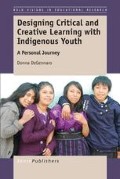Abstract
I promised myself when I decided to write this book that I would not make it theoretical. Using theoretical language in and of itself creates a power dynamic between those with whom you wish to work and those who might identify with the nature of the work you are doing. That said to deny theory would be irresponsible. It would again create the dichotomy between the academy and the field. It would also negate the role of theory in assisting us in analyzing both our position, our presence, and self, moreover the implications each of these and in informing the design of learning.
Access this chapter
Tax calculation will be finalised at checkout
Purchases are for personal use only
Preview
Unable to display preview. Download preview PDF.
References
Braden, S. (1999). Using video for research and representation: Basic human needs and critical pedagogy. Journal of Educational Media, 24(2), 117–129.
Chavez, V., & Soep, E. (2005). Youth radio and the pedagogy of collegiality. Harvard Educational Review, 75(4), 409–434.
Collins, A., Brown, J. S., & Holum, A. (1991). Cognitive apprenticeship: Making thinking visible. American Educator, 6(11), 38–46.
DeGennaro, D. (2008a). Sociotechnical cultural activity: Expanding an understanding of developing technology practices. Journal of Curriculum Studies, 40(3), 329–351.
DeGennaro, D. (2008b). Learning designs: Tapping technology fluency of the Net Generation. Journal of Research on Technology in Education, 40(1), 81–100.
DeGennaro, D. (2010). Grounded in theory: Immersing preservice teachers in technology-mediated learning. Contemporary Issues in Technology and Teacher Education, 10(3), 338–359.
DeGennaro, D., & Brown, T. (2009a). Youth voices: Exploring connections between history agency and identity in a digital divide initiative. Cultural Studies of Science Education, 4(1), 13–39.
DeGennaro, D., & Brown, T. (2009b). Emergent fields through adaptation and identity: Overcoming social distance. Cultural Studies in Science Education, 4(1), 77–87.
DeGennaro, D., & Brown, T. L. (2014). Youth media productions: Deconstructing “difference” or reifying norms? In K. Tobin, C. Milne, & D. DeGennaro (Eds.), Sociocultural studies and implications for science education: The experiential and the virtual. Dordrecht, The Netherlands: Springer.
DeGennaro, D., & Duque, R. (2013). Video of the oppressed: Insights into local knowledge, perspectives, and interests with youth. In T. Kress, C. Malott, & B. Porilio (Eds.), Challenging status quo retrenchment: New directions in critical qualitative research. Charlotte, NC: Information Age Publishing.
Freire, P. (1970). Pedagogy of the oppressed. New York, NY: The Seabury Press.
Freire, P. (1973). Education for critical consciousness. New York, NY: The Seabury Press.
Freire, P. (1990). Aurora Online with Paulo Freire: Twenty years later: Similar problems, different solutions. Interview with Carlos Torres.
Goodman, S. (2003). Teaching youth media: A critical guide to literacy, video production and social change. New York, NY: Teachers College Press.
Grande, S. (2004). Red pedagogy: Native American social and political thought. Lanham, MD: Rowman & Littlefield.
Guba, E. G., & Lincoln, Y. S. (1989). Fourth generation evaluation models. Newbury Park, CA: Sage.
Hall, S. (1973). Encoding and decoding in the television discourse. Birmingham, England: CCS.
Ito, M., & Okabe, D. (2006). Technosocial situations: Emergent structurings of mobile email use. In M. Ito, M. Matsuda, & D. Okabe (Eds.), Personal, portable intimate: Mobile phones in Japanese life (pp. 257–276). Cambridge, MA: MIT Press.
Johansson, L. (1999). Participatory video and PRA: Acknowledging the politics of empowerment. Forests, Trees, and People, Newsletter, 40/41, 21–23.
Kellner, D. (2000). Multiple literacies and critical pedagogies. In P. P. Trifonas (Ed.), Revolutionary pedagogies: Cultural politics, instituting education, and the discourse of theory. New York, NY: Routledge.
Kellner, D., & Kim, G. (2009). YouTube, politics, and pedagogy: Some critical reflections. In R. Hammer & D. Kellner (Eds.), Media/cultural studies: Critical approaches (pp. 615–636). New York, NY: Peter Lang Publishing.
Kvasny, L., & Keil, M. (2006). The challenges of redressing the digital divide: A tale of two US cities. Information Systems Journal, 16(1), 23–53.
Lambert, J. (2002). Digital storytelling: Capturing lives, creating community. Berkeley, CA: Digital Diner Press.
Lenhart, A., Madden, M., & Hitlin, P. (2005). Teens and technology. Washington, DC: Pew Internet & American Life Project. Retrieved March 12, 2007, from http://www.pewinternet.org/pdfs/PIP_Teens_Tech_July2005web.pdf
Roth, W.-M., Tobin, K., & Ritchie, S. M. (2007). Time and temporality as mediators of science learning. Science Education, 92, 115–140.
Sawyer, K. (Ed.). (2014). The Cambridge handbook of the learning sciences (2nd ed.). Cambridge, England: Cambridge University Press.
Sewell, W. H. (1992). A theory of structure: Duality, agency, and transformation. American Journal of Sociology, 98, 1–29.
Sewell, W. H. (1999). The concept(s) of culture. In V. E. Bonnell & L. Hunt (Eds.), Beyond the cultural turn: New directions in the study of society and culture (pp. 35–61). Berkeley, CA: University of California Press.
Shrum, W., Duque, R., & Brown, T. (2005). Digital video as research practice: Methodology for the millennium. Journal of Research Practice, 1(1), Article M4.
Steinberg, S. R. (2007). Where are we now? In P. McLaren & J. L. Kincheloe (Eds.), Critical pedagogy: Where are we now? (pp. ix–x). New York, NY: Peter Lang.
Steinberg, S. R., & Kincheloe, J. L. (1998). Students as researchers: Creating classrooms that matter. Bristol, PA: Falmer Press, Taylor & Francis.
Tapscott, D. (2002). Growing up digital: The rise of the net generation. New York, NY: McGraw Hill.
Author information
Authors and Affiliations
Rights and permissions
Copyright information
© 2016 Sense Publishers
About this chapter
Cite this chapter
DeGennaro, D. (2016). Theoretical Foundations. In: Designing Critical and Creative Learning with Indigenous Youth. Bold Visions in Educational Research. SensePublishers, Rotterdam. https://doi.org/10.1007/978-94-6300-307-0_3
Download citation
DOI: https://doi.org/10.1007/978-94-6300-307-0_3
Publisher Name: SensePublishers, Rotterdam
Online ISBN: 978-94-6300-307-0
eBook Packages: EducationEducation (R0)

